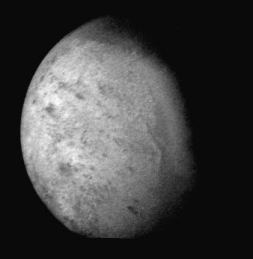
![]() Main Page
Main Page
![]() Feedback
Feedback
 The Author
The Author
 News
News
 Search
Search
 The Planets
The Planets
 Mercury
Mercury
 Venus
Venus
 Earth
Earth
 Mars
Mars
 Jupiter
Jupiter
 Saturn
Saturn
 Uranus
Uranus
 Neptune
Neptune
 Pluto
Pluto
 Dwarf Planets
Dwarf Planets
 The Solar System
The Solar System
 The Sun
The Sun
 The Moon
The Moon
 Meteors
Meteors
 Comets
Comets
 Asteroids
Asteroids
 Amazing facts
Amazing facts
 Other
Resources
Other
Resources
 Poster Store
Poster Store
 Multimedia
Multimedia
 Links
Links
 Awards
Awards
 Glossary
Glossary
 Astronomers
Astronomers
 Webrings
Webrings
 Bibliography
Bibliography

Technical Data:-
| Diameter | 2,704 km |
| Average Distance from Neptune | 354,800 km |
| Average surface Temperature | -235°C (38.2 K) |
| Length of Day | 5.88 (retrograde) |
| Length of Year | 5.88 |
| Eccentricity of Orbit | 0.000016 |
| Density | 2.07 gm/cm3 |
| Atmosphere | n/a |
More pictures of Triton Here |
|
Discovered by William Lassell in 1846, Triton is one of the most interesting moons in the Solar System, and one which has increasingly been studied by scientists. Triton a pretty large moon, having a diameter of 2,700 km and is Neptune's seventh satellite. It has only been visited by one space probe, the Voyager 2, and as such we dont have too much information about it yet, although a mission to Triton sometime in the future is expected. Triton is unusual as a moon in quite a number of ways. Firstly it is tilted 157 degrees to Neptune's axis, and even more towards the Sun, so it is prone to large seasonal changes in temperature. These changes in temperature are believed to be the cause of Triton's strange volcanoes discovered by Voyager which, instead of erupting rocks like conventional volcanoes here on Earth or on Venus, spurts out what is believed to be liquid nitrogen or methane compounds. Triton is fairly crater-free, implying a young surface. It is also incidentaly a very cold surfce, with temperatures dropping to just 34.5 K (-235 C). Like Mars' moon Phobos, Triton is expected to, sometime in the distant future, crash into Neptune, due to a combination of Triton's (unusual) retrograde orbit and tidal interactions with Neptune. The high density of Triton (denser even than Saturn's ice moons), along with its exceptional retrograde orbit has led many scientists to believe that it is a celestial object captured by Neptune some time ago. |
|